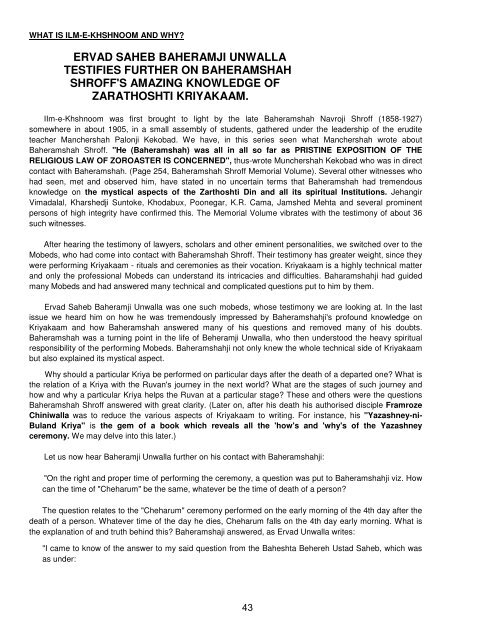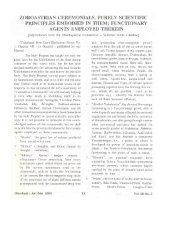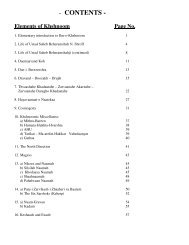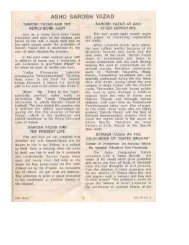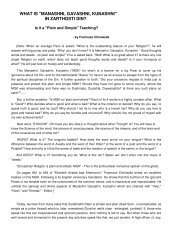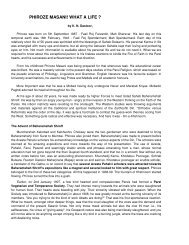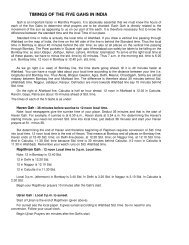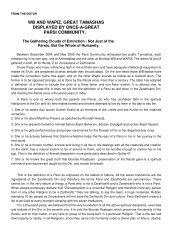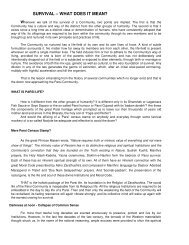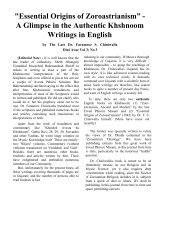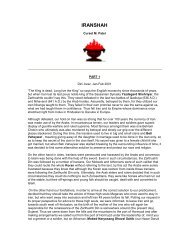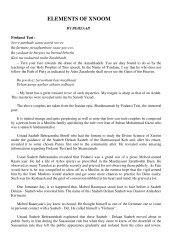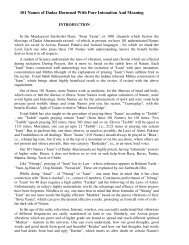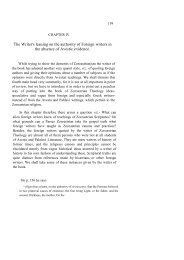Ilm-e-Khshnoom - Traditional Zoroastrianism: Tenets of the Religion
Ilm-e-Khshnoom - Traditional Zoroastrianism: Tenets of the Religion
Ilm-e-Khshnoom - Traditional Zoroastrianism: Tenets of the Religion
You also want an ePaper? Increase the reach of your titles
YUMPU automatically turns print PDFs into web optimized ePapers that Google loves.
WHAT IS ILM-E-KHSHNOOM AND WHY?<br />
ERVAD SAHEB BAHERAMJI UNWALLA<br />
TESTIFIES FURTHER ON BAHERAMSHAH<br />
SHROFF'S AMAZING KNOWLEDGE OF<br />
ZARATHOSHTI KRIYAKAAM.<br />
IIm-e-<strong>Khshnoom</strong> was first brought to light by <strong>the</strong> late Baheramshah Navroji Shr<strong>of</strong>f (1858-1927)<br />
somewhere in about 1905, in a small assembly <strong>of</strong> students, ga<strong>the</strong>red under <strong>the</strong> leadership <strong>of</strong> <strong>the</strong> erudite<br />
teacher Manchershah Palonji Kekobad. We have, in this series seen what Manchershah wrote about<br />
Baheramshah Shr<strong>of</strong>f. "He (Baheramshah) was all in all so far as PRISTINE EXPOSITION OF THE<br />
RELIGIOUS LAW OF ZOROASTER IS CONCERNED", thus-wrote Munchershah Kekobad who was in direct<br />
contact with Baheramshah. (Page 254, Baheramshah Shr<strong>of</strong>f Memorial Volume). Several o<strong>the</strong>r witnesses who<br />
had seen, met and observed him, have stated in no uncertain terms that Baheramshah had tremendous<br />
knowledge on <strong>the</strong> mystical aspects <strong>of</strong> <strong>the</strong> Zarthoshti Din and all its spiritual Institutions. Jehangir<br />
Vimadalal, Kharshedji Suntoke, Khodabux, Poonegar, K.R. Cama, Jamshed Mehta and several prominent<br />
persons <strong>of</strong> high integrity have confirmed this. The Memorial Volume vibrates with <strong>the</strong> testimony <strong>of</strong> about 36<br />
such witnesses.<br />
After hearing <strong>the</strong> testimony <strong>of</strong> lawyers, scholars and o<strong>the</strong>r eminent personalities, we switched over to <strong>the</strong><br />
Mobeds, who had come into contact with Baheramshah Shr<strong>of</strong>f. Their testimony has greater weight, since <strong>the</strong>y<br />
were performing Kriyakaam - rituals and ceremonies as <strong>the</strong>ir vocation. Kriyakaam is a highly technical matter<br />
and only <strong>the</strong> pr<strong>of</strong>essional Mobeds can understand its intricacies and difficulties. Baharamshahji had guided<br />
many Mobeds and had answered many technical and complicated questions put to him by <strong>the</strong>m.<br />
Ervad Saheb Baheramji Unwalla was one such mobeds, whose testimony we are looking at. In <strong>the</strong> last<br />
issue we heard him on how he was tremendously impressed by Baheramshahji's pr<strong>of</strong>ound knowledge on<br />
Kriyakaam and how Baheramshah answered many <strong>of</strong> his questions and removed many <strong>of</strong> his doubts.<br />
Baheramshah was a turning point in <strong>the</strong> life <strong>of</strong> Beheramji Unwalla, who <strong>the</strong>n understood <strong>the</strong> heavy spiritual<br />
responsibility <strong>of</strong> <strong>the</strong> performing Mobeds. Baheramshahji not only knew <strong>the</strong> whole technical side <strong>of</strong> Kriyakaam<br />
but also explained its mystical aspect.<br />
Why should a particular Kriya be performed on particular days after <strong>the</strong> death <strong>of</strong> a departed one? What is<br />
<strong>the</strong> relation <strong>of</strong> a Kriya with <strong>the</strong> Ruvan's journey in <strong>the</strong> next world? What are <strong>the</strong> stages <strong>of</strong> such journey and<br />
how and why a particular Kriya helps <strong>the</strong> Ruvan at a particular stage? These and o<strong>the</strong>rs were <strong>the</strong> questions<br />
Baheramshah Shr<strong>of</strong>f answered with great clarity. (Later on, after his death his authorised disciple Framroze<br />
Chiniwalla was to reduce <strong>the</strong> various aspects <strong>of</strong> Kriyakaam to writing. For instance, his "Yazashney-ni-<br />
Buland Kriya" is <strong>the</strong> gem <strong>of</strong> a book which reveals all <strong>the</strong> 'how's and 'why's <strong>of</strong> <strong>the</strong> Yazashney<br />
ceremony. We may delve into this later.)<br />
Let us now hear Baheramji Unwalla fur<strong>the</strong>r on his contact with Baheramshahji:<br />
"On <strong>the</strong> right and proper time <strong>of</strong> performing <strong>the</strong> ceremony, a question was put to Baheramshahji viz. How<br />
can <strong>the</strong> time <strong>of</strong> "Cheharum" be <strong>the</strong> same, whatever be <strong>the</strong> time <strong>of</strong> death <strong>of</strong> a person?<br />
The question relates to <strong>the</strong> "Cheharum" ceremony performed on <strong>the</strong> early morning <strong>of</strong> <strong>the</strong> 4th day after <strong>the</strong><br />
death <strong>of</strong> a person. Whatever time <strong>of</strong> <strong>the</strong> day he dies, Cheharum falls on <strong>the</strong> 4th day early morning. What is<br />
<strong>the</strong> explanation <strong>of</strong> and truth behind this? Baheramshaji answered, as Ervad Unwalla writes:<br />
"I came to know <strong>of</strong> <strong>the</strong> answer to my said question from <strong>the</strong> Baheshta Behereh Ustad Saheb, which was<br />
as under:<br />
43


